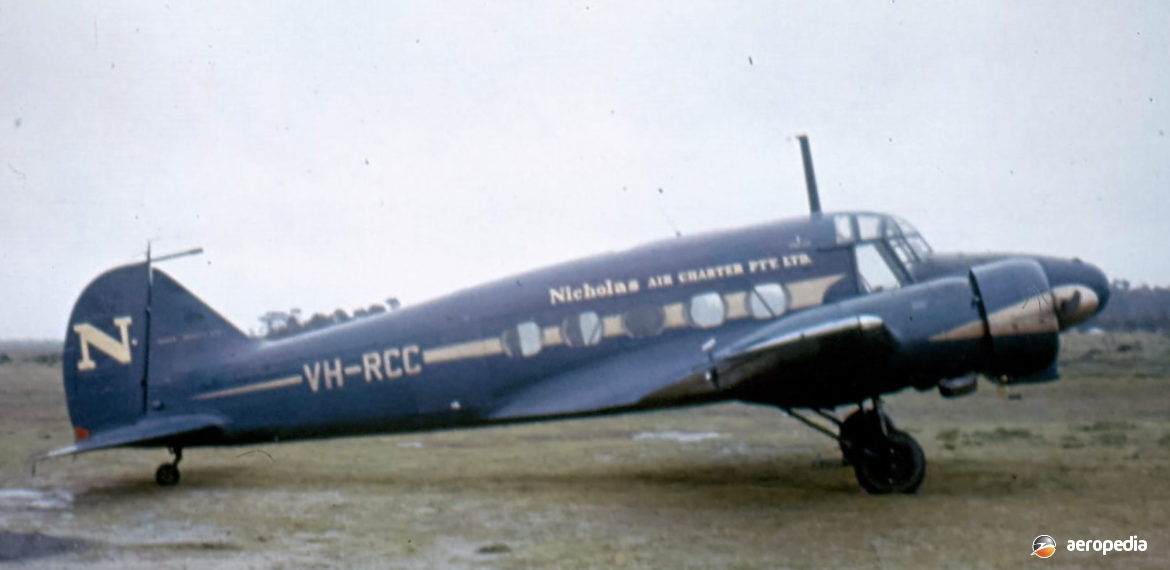Photograph:
Avro XIX VH-RCC (c/n 1351) of Nicholas Air Charter at Parafield, SA (Geoff Goodall)
Country of origin:
United Kingdom
Description:
Light twin-engine commercial airliner
Power Plant:
Two 313 kw (420 hp) Armstrong Siddeley Cheetah 17 seven-cylinder air-cooled radial engines
Specifications:
- Wingspan: 17.22 m (56 ft 6 in)
- Length: 12.89 m (42 ft 3 in)
- Height: 4.23 m (13 ft 10 in)
- Wing area: 43.01 m² (463 sq ft)
- Max speed at 1,524 m (5,000 ft): 306 km/h (190 mph)
- Max cruising speed: 280 km/h (174 mph)
- Economical cruising speed: 241 km/h (150 mph)
- Stalling speed: 107 km/h (67 mph)
- Rate of climb at sea level: 229 m/min (750 ft/min)
- Service ceiling: 5,791 m (19,000 ft)
- Single engine ceiling: 1,753 m (5,750 ft)
- Take-off run to clear 15 m (50 ft) obstacle: 640 m (2,100 ft)
- Max range with six passengers: 982 km (610 miles)
- Range with nine passengers: 563 km (350 miles)
- Fuel capacity: 1,723 litres (280 Imp gals)
- Empty weight: 3,365 kg (7,419 lb)
- Loaded weight: 4,717 kg (10,400 lb)
History:
The Avro XIX, 19, or Model 552A, as it was known, was a development of the Avro Anson for use by the RAF as a personnel transport late in World War II. It differed in having a deeper fuselage with more headroom to allow easier access for passengers, and had a tapered metal wing. The Avro XIX was adapted for use by the RAF, becoming the C Mk 19, and was used for communications duties. The Series 1 (98 built) retained the wooden wings and tailplane of the earlier models, and the Series 2 (158 built) had metal wings and tailplane. Eventually nearly all Series 1 aircraft were brought up to Series 2 standard by the fitting of the metal wing.
Initial order for the RAF was for 25 aircraft, later increased to 160. A total of 252 was built at Yeadon in West Yorkshire to Mk 21 standards. Variants included the T Mks 20 to 22, the Mk 20 being a navigation trainer for use in tropical climates which was fitted out to carry sixteen 3.9 kg (8.5 lb) light bombs; the Mk 21 being an English-based navigation trainer; and the Mk 22 being a radio trainer. The type was finally retired from RAF service on 28 June 1968.
The prototype Mk XIX (MG159) was initially partially built as a Mk 1 but was modified to become the prototype Mk XII before being modified to XIX standard with five oval windows on each side and a lowered entrance door on the port side. Production of Avro XIXs continued up to 1947. It was also used as light transport, feeder-line or executive aircraft.
British European Airways (BEA) obtained thirteen in 1947 after their retirement from RAF service and operated them on routes in Northern Ireland. However, they were not considered to be successful in this role due to excessive noise and vibration and only remained in service for a few years. Four remained in BEA service for crew training at Cranfield in Bedfordshire, and Northolt in Middlesex until 1950. Civil operators in the United Kingdom included Railway Air Services, Hunting Air Travel Ltd, Channel Air Services, Sivewright, Westminster Airways, Starways, etc, and a number were sold in Europe.
Two Anson C.19s were operated by the RAAF. These aircraft were Model 652As (VM374 and VM375) and during their service in Australia in the 1950s with No 34 Squadron operated from Woomera, SA with their RAF serials and were not allotted serials in the A4- series, which had been allotted to the Avro Anson. During December 1950 VM375 was operated on bush fire patrol work between Mildura, VIC, Broken Hill, NSW and Renmark, SA. After RAAF service VM375 was sold and converted to civil use in 1957, being placed on the Australian Civil Aircraft Register as VH-BIX. It suffered a forced landing at Lancelin Island, WA on 22 March 1961. The fate of VM374 is not known but it is believed to have been broken up.
An Anson Mk XII (NL153) was imported to Australia. This machine also operated during its life with its RAF serial, being used by the Governor General’s Flight after World War II. The Mk XII used the fuselage of the passenger configured C.19 but had the wooden wing fitted to the Anson Is operated by the RAAF, the fuselage windows being in a slightly different configuration.
Another XIX became VH-RCC (c/n 1351 – ex G-AHXK), being imported by Nicholas Air Charter of Parafield, SA, being used on charter and freight work for some years. After retirement it was broken up. The wing was converted for use by Brown & Brain of Essendon, VIC and was fitted to the then surviving Anson 1, VH-BAF. After being flown as a freighter by the company for some years, it became a private aircraft, sometimes being seen at aviation events in Victoria. Eventually it was placed on display at Airworld, Wangaratta, where it stayed for some years until exported to New Zealand in 2004 where it has been restored, painted in wartime RNZAF markings, fitted with a turret, and registered to its owner as ZK-RRA at Nelson.
A further Mk XIX, registered as a Model 652A XII (ZK-AXY – ex PH599), also operated in New Zealand, initially by Southern Scenic Air Service Ltd of Cromwell, Otago, and was unusual in having long square windows in the fuselage in lieu of the oval normally fitted to the XIX series. This aircraft, which seated seven, alongside an Anson 1 ZK-BCL, operated from mid-1953 on the Queenstown to Dunedin service, and from December 1953 on the Queenstown to Taireri service. It was eventually replaced by a DH.89 Dominie and placed in storage. In December 1982 it was stripped for parts and scrapped.

